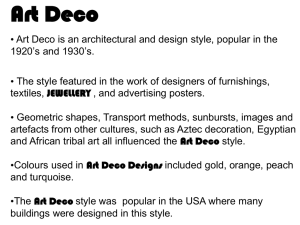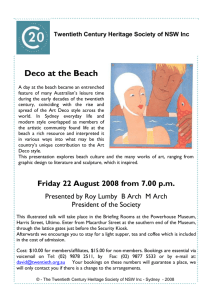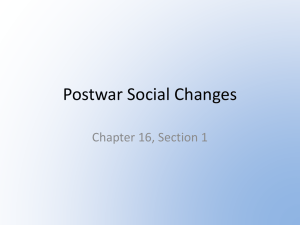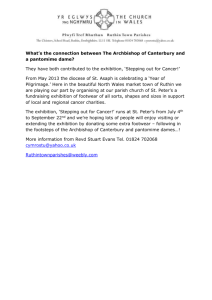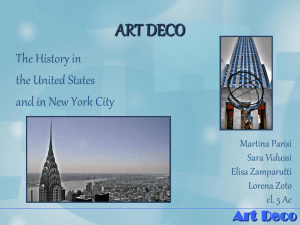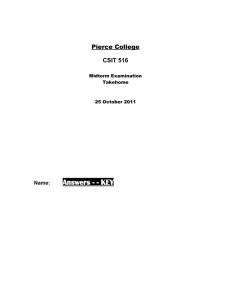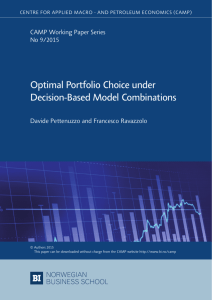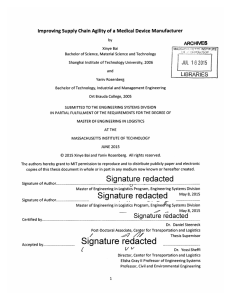Art Deco (Word file, 37 KB) - Victoria and Albert Museum
advertisement
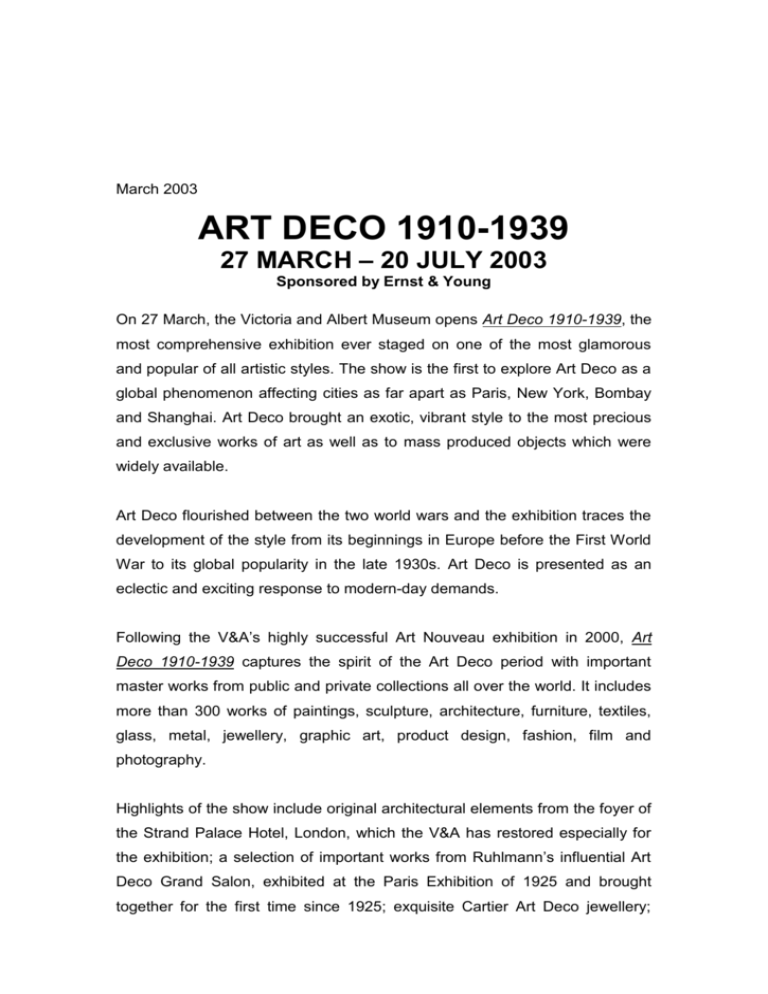
March 2003 ART DECO 1910-1939 27 MARCH – 20 JULY 2003 Sponsored by Ernst & Young On 27 March, the Victoria and Albert Museum opens Art Deco 1910-1939, the most comprehensive exhibition ever staged on one of the most glamorous and popular of all artistic styles. The show is the first to explore Art Deco as a global phenomenon affecting cities as far apart as Paris, New York, Bombay and Shanghai. Art Deco brought an exotic, vibrant style to the most precious and exclusive works of art as well as to mass produced objects which were widely available. Art Deco flourished between the two world wars and the exhibition traces the development of the style from its beginnings in Europe before the First World War to its global popularity in the late 1930s. Art Deco is presented as an eclectic and exciting response to modern-day demands. Following the V&A’s highly successful Art Nouveau exhibition in 2000, Art Deco 1910-1939 captures the spirit of the Art Deco period with important master works from public and private collections all over the world. It includes more than 300 works of paintings, sculpture, architecture, furniture, textiles, glass, metal, jewellery, graphic art, product design, fashion, film and photography. Highlights of the show include original architectural elements from the foyer of the Strand Palace Hotel, London, which the V&A has restored especially for the exhibition; a selection of important works from Ruhlmann’s influential Art Deco Grand Salon, exhibited at the Paris Exhibition of 1925 and brought together for the first time since 1925; exquisite Cartier Art Deco jewellery; paintings and sculpture by some of the most important artists of the century including Fernand Léger, Sonia and Robert Delaunay and Constantin Brancusi; and fashion by such eminent designers as Jeanne Lanvin, Coco Chanel, Elsa Schiaperelli and Madeleine Vionnet. Ghislaine Wood, curator of the exhibition, said: "For much of this century Art Deco has been dismissed as a purely hedonistic and frivolous style. The exhibition explores how Art Deco in fact represented new values and responded to human needs through the conscious celebration of fantasy, fun, glamour and commerce. It became a universal phenomenon transforming the look of everything from factories and cinemas to fashion and photography. Art Deco is arguably the most popular style of the century and one that has enormous appeal for people all over the world today". The Deco period began in 1910 when Art Nouveau slid out of fashion. Its highpoint was in 1925 at the Paris exhibition, the Exposition Internationale des Arts Decoratifs et Industriels Modernes, and the style culminated at the New York World’s Fair in 1939. The term Art Deco was coined in 1966 and was taken from the Paris exhibition in 1925. Before this the style was known by a variety of terms including ‘Jazz Moderne’, ‘Streamline Moderne’ or simply ‘Moderne’. After London, the exhibition will travel to the Royal Ontario Museum in Toronto in the Autumn of 2003, the Museum of Fine Arts in San Francisco in the Spring of 2004 and will end with the Museum of Fine Arts, Boston in Autumn 2004. Four new books have been published by V&A Publications to coincide with the opening of this exhibition. Notes to Editors The exhibition has been designed by Casson Mann. Tickets for Art Deco are as follows: £8 for adults, £5 for senior citizens and full-time students Free for under 18s, disabled people and carers, ES40 holders, V&A Friends and Patrons, NACF/ICOM/Museums Association cardholders. To book tickets, please log on to www.vam.ac.uk or call 0870 906 3883. Booking fee per ticket: £1.40 (on the full price tickets), £1.10 (on the concession price tickets). For further PRESS information, please contact Patricia O’Connor or Gareth Harris, on 020 7942 2502. Email: p.oconnor@vam.ac.uk and g.harris@vam.ac.uk (not for publication). A selection of images are available on www.image.net. For general enquiries: 020 7942 2000. www.vam.ac.uk. The exhibition is sponsored by
